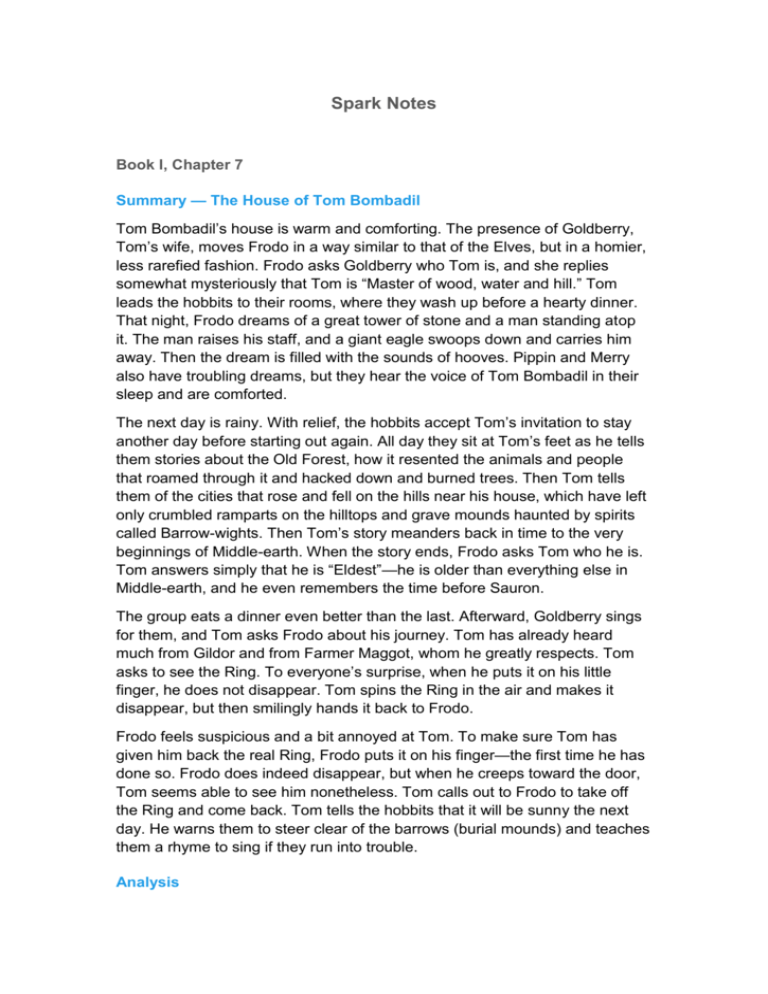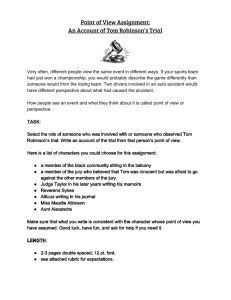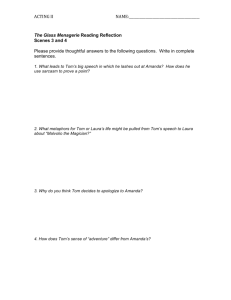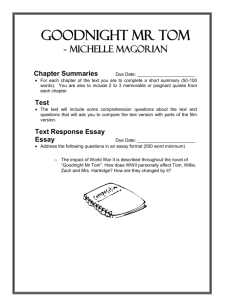Spark Notes
advertisement

Spark Notes Book I, Chapter 7 Summary — The House of Tom Bombadil Tom Bombadil’s house is warm and comforting. The presence of Goldberry, Tom’s wife, moves Frodo in a way similar to that of the Elves, but in a homier, less rarefied fashion. Frodo asks Goldberry who Tom is, and she replies somewhat mysteriously that Tom is “Master of wood, water and hill.” Tom leads the hobbits to their rooms, where they wash up before a hearty dinner. That night, Frodo dreams of a great tower of stone and a man standing atop it. The man raises his staff, and a giant eagle swoops down and carries him away. Then the dream is filled with the sounds of hooves. Pippin and Merry also have troubling dreams, but they hear the voice of Tom Bombadil in their sleep and are comforted. The next day is rainy. With relief, the hobbits accept Tom’s invitation to stay another day before starting out again. All day they sit at Tom’s feet as he tells them stories about the Old Forest, how it resented the animals and people that roamed through it and hacked down and burned trees. Then Tom tells them of the cities that rose and fell on the hills near his house, which have left only crumbled ramparts on the hilltops and grave mounds haunted by spirits called Barrow-wights. Then Tom’s story meanders back in time to the very beginnings of Middle-earth. When the story ends, Frodo asks Tom who he is. Tom answers simply that he is “Eldest”—he is older than everything else in Middle-earth, and he even remembers the time before Sauron. The group eats a dinner even better than the last. Afterward, Goldberry sings for them, and Tom asks Frodo about his journey. Tom has already heard much from Gildor and from Farmer Maggot, whom he greatly respects. Tom asks to see the Ring. To everyone’s surprise, when he puts it on his little finger, he does not disappear. Tom spins the Ring in the air and makes it disappear, but then smilingly hands it back to Frodo. Frodo feels suspicious and a bit annoyed at Tom. To make sure Tom has given him back the real Ring, Frodo puts it on his finger—the first time he has done so. Frodo does indeed disappear, but when he creeps toward the door, Tom seems able to see him nonetheless. Tom calls out to Frodo to take off the Ring and come back. Tom tells the hobbits that it will be sunny the next day. He warns them to steer clear of the barrows (burial mounds) and teaches them a rhyme to sing if they run into trouble. Analysis If Tom Bombadil does not quite seem to fit with the rest of the novel thus far, it may be because Tolkien created the character as early as 1933, years before he began The Lord of the Rings. Tolkien clearly liked the idea of Tom, and he even tossed around the prospect of making Tom the hero of the sequel to The Hobbit. (Eventually Tolkien would write The Adventures of Tom Bombadil, a collection of poems, in 1961.) Ultimately, Tolkien ended up transplanting Tom into The Lord of the Rings. However, as the novel progresses and grows darker, Tom, in retrospect, may seem to belong more in the children’s story of The Hobbit than in the more threatening world of The Lord of the Rings. Nonetheless, Tolkien did not regret his decision to keep Tom in the final edit of The Lord of the Rings; the author later said, “I kept [Tom] in, and as he was, because he represents certain things otherwise left out.” These “certain things” Tom represents are a matter of great debate among Tolkien scholars, as Tom is indeed a mysterious figure. Perhaps the only thing we know definitively about him is that he is joyously immune to the power of the Ring, and therefore a unique, neutral third party in the wider landscape of the War of the Ring that is to come. Tom is something like a male personification of Mother Nature, the master of the land and its creatures, albeit only within his own territory. He clearly has great powers, and the Ring does not affect him, perhaps because he was around before Sauron ever came to Middle-earth. However, Tom refuses to go with the hobbits to fight Sauron, and we get the feeling that Tom’s power has perhaps diminished somewhat in the later ages of Middle-earth. Tom’s presence, like that of the Elves, contributes to the overall tone of elegy in The Lord of the Rings, a sadness for the lost past. Like the Elves, Tom has a power that is closely linked to nature, but with Tom the link is even more explicit. Frodo’s feeling when he first steps into Tom’s house—that the place has a demeanor that is “less keen and lofty,” but “deeper”—suggests this distinction between Tom and the Elves. The importance and characteristics of Tom Bombadil also give clues about Tolkien’s conception of nature. When the hobbits arrive at Tom’s house, Goldberry tells them that now they need not worry about “untame things.” This wording, combined with the perfectly manicured landscape around Tom’s house, suggests that Tolkien does not necessarily view nature as the same thing as wildness or pristine wilderness. Nature, without the controlling hand of man, is unruly and perhaps even unsafe. The most idyllic places in Tolkien’s world—whether the comfortable confines of the Shire, the magical bower of the High Elves, or Tom’s domain—are places where nature has been tamed. This idea of a domesticated, softened nature is often cited in literature, music, and the visual arts as the ideal of the pastoral. For Tolkien, the pastoral has a powerful appeal. Tom speaks briefly to the hobbits about the kings of Westernesse, some of whom held kingdoms and fought battles where the Barrow-downs now lie. Westernesse is the land west of Middle-earth, given by the Valar (the angelic gods of Middle-earth) as a reward to the men who fought against Morgoth, the Great Enemy (and Sauron’s master), in the First Age. The land of Westernesse is also known as Númenor. Because some of its inhabitants grew restless and proud, they sailed back to Middle-earth and a few fell under the rule of Sauron. Still, they were considered the greatest race of Men in the world. Isildur, who took the Ring from Sauron, was a Númenorean, and it was Númenóreans who lived in the North near the Barrow-downs and fought Sauron’s servants from the ancient northern realm of Angmar. Now, however, there are but a few Men of pure Westernesse blood left. As we see later, those who remain have a crucial role to play in the story of The Lord of the Rings.







